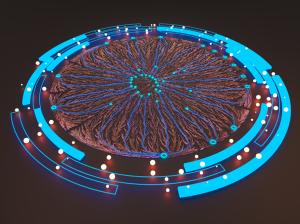Presented By: DCMB Seminar Series
DCMB Weekly Seminar
Joerg Lahann (Professor, Chemical Engineering), "Biomolecular Engineering of Materials and Interfaces"

Abstract:
The intersect between the life sciences (cells, tissues, organs) and engineered materials (polymers, biomacromolecules, semiconductors) is crucial for a wide range of medical and biotechnological applications. Hence, the precise control of biotic/abiotic interfaces has been one of the main obstacles of past decades. The Lahann Lab designs polymers for a range of different medical applications. In particular, we have developed a class of protein nanoparticles for targeting of glioblastoma. In addition, I will summarize our efforts related to sheet-like 3D organoid systems and will address recent advances with morphologically designed interfaces.
Research Interests:
Designer surfaces, advanced polymers, biomimetic materials, microfluidic devices, engineered microenvironments, nano-scale self-assembly.
Joerg Lahann’s research is broadly related to surface engineering with strong ties to biomedical engineering and nanotechnology. His research on reversibly switching surfaces was featured in an article in Science (J. Lahann, et al., A Reversibly Switching Surface, January 17, 2003, 299, 371-374.) These “smart surfaces” can reversibly switch properties in response to an external stimulus. To demonstrate these findings, a surface design was developed that can be changed from water-attracting to water-repelling with the application of a weak electric field. Designed as a switch, single-layered molecular-level machines are aligned on a surface using self-assembly and then are flipped between defined microscopic states. This type of surface design may offer a new paradigm for interfacial engineering as it amplifies reversible conformational transitions at a molecular level to macroscopic changes in surface properties without altering the chemical identity of the surface.
Joerg has also developed a novel class of polymers with potential for biomimetic and spatially directed surface engineering. This “reactive coating” technology uses chemical vapor deposition (CVD) polymerization to deposit a wide range of chemical signatures on various substrate materials. Its simplicity in providing chemically reactive groups and its applicability to three-dimensional geometries (e.g., for microfluidics) enables the exact tailoring of surface properties and the preparation of biologically relevant microenvironments. Reactive coatings are compatible with soft lithographic processes, allowing for patterning of proteins, DNA, cytokines, and mammalian cells.
The intersect between the life sciences (cells, tissues, organs) and engineered materials (polymers, biomacromolecules, semiconductors) is crucial for a wide range of medical and biotechnological applications. Hence, the precise control of biotic/abiotic interfaces has been one of the main obstacles of past decades. The Lahann Lab designs polymers for a range of different medical applications. In particular, we have developed a class of protein nanoparticles for targeting of glioblastoma. In addition, I will summarize our efforts related to sheet-like 3D organoid systems and will address recent advances with morphologically designed interfaces.
Research Interests:
Designer surfaces, advanced polymers, biomimetic materials, microfluidic devices, engineered microenvironments, nano-scale self-assembly.
Joerg Lahann’s research is broadly related to surface engineering with strong ties to biomedical engineering and nanotechnology. His research on reversibly switching surfaces was featured in an article in Science (J. Lahann, et al., A Reversibly Switching Surface, January 17, 2003, 299, 371-374.) These “smart surfaces” can reversibly switch properties in response to an external stimulus. To demonstrate these findings, a surface design was developed that can be changed from water-attracting to water-repelling with the application of a weak electric field. Designed as a switch, single-layered molecular-level machines are aligned on a surface using self-assembly and then are flipped between defined microscopic states. This type of surface design may offer a new paradigm for interfacial engineering as it amplifies reversible conformational transitions at a molecular level to macroscopic changes in surface properties without altering the chemical identity of the surface.
Joerg has also developed a novel class of polymers with potential for biomimetic and spatially directed surface engineering. This “reactive coating” technology uses chemical vapor deposition (CVD) polymerization to deposit a wide range of chemical signatures on various substrate materials. Its simplicity in providing chemically reactive groups and its applicability to three-dimensional geometries (e.g., for microfluidics) enables the exact tailoring of surface properties and the preparation of biologically relevant microenvironments. Reactive coatings are compatible with soft lithographic processes, allowing for patterning of proteins, DNA, cytokines, and mammalian cells.